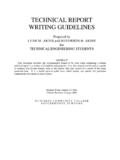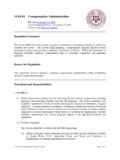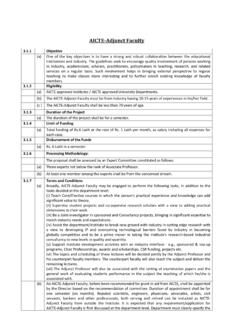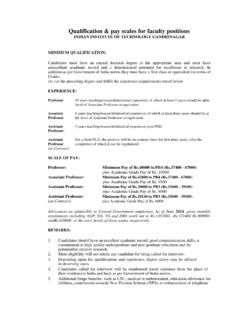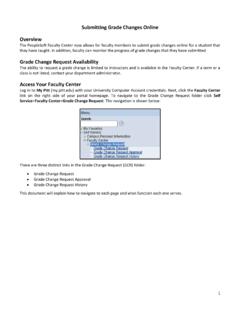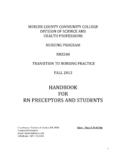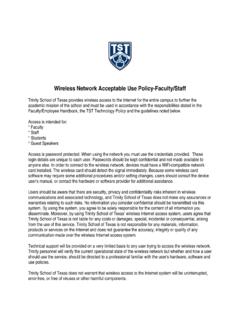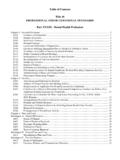Transcription of Technical Report Writing Guidelines
1 Technical Report Writing Guidelines Prepared by LEAH M. AKINS and JEFFERSON H. AKINS for Technical /ENGINEERING STUDENTS ABSTRACT This document specifies the recommended format to be used when submitting a formal Technical Report in a variety of disciplines and purposes. Also, this manual can be used as a guide to compose less formal reports, such as lab reports, that may consist of a subset of the items presented here. It is a useful general guide from which faculty can specify the particular requirements for reports in their courses. Original Work: January 13, 2001 Current Revision: January 2009 D U T C H E S S C O M M U N I T Y C O L L E G E P O U G H K E E P S I E , N E W Y O R K Table of Contents INTRODUCTION .. 1 THE FORMAL Technical Report .. 1 UNIVERSAL ASPECTS OF ALL REPORTS .. 1 Report FORMAT .. 2 TITLE PAGE .. 2 ABSTRACT.
2 2 TABLE OF CONTENTS .. 2 INTRODUCTION .. 2 BACKGROUND THEORY .. 3 DESIGN / THEORETICAL ANALYSIS .. 3 PROCEDURE .. 3 RESULTS AND DISCUSSION .. 5 CONCLUSION .. 5 WORKS CITED .. 6 APPENDIX .. 6 HOW A READER IN INDUSTRY PERUSES A Technical Report AND WHY YOU SHOULD KNOW .. 6 CONCLUSION .. 6 WORKS CITED .. 7 Appendix A Creating Works Cited Page and Citations within Report .. 8 Citing an Article in a Periodical [1] .. 8 Citing a Book [1] .. 8 Citing Full Text Databases Using APA Format [2] .. 8 Citing World Wide Web Documents [2] .. 9 Creating Parenthetical Citations Using APA Format [3] .. 9 Appendix B Writing Tips for Results and Discussion Section .. 10 Percent Difference/Error .. 10 Magnitude of Error .. 10 Writing Discussion Based on Lab 10 Guidelines for Graphs .. 11 APPENDIX C Guidelines FOR ANSWERING Technical QUESTIONS .. 12 1 INTRODUCTION The purpose of a Technical Report is to completely and clearly describe Technical work, why it was done, results obtained and implications of those results.
3 The Technical Report serves as a means of communicating the work to others and possibly providing useful information about that work at some later date. A well written Report allows the reader to quickly understand what has been accomplished. The Report also provides sufficient detail to allow the reader to recreate the results although the level of detail provided depends heavily on the Report s audience and any proprietary nature of the work. Clear presentation of results is at least as important as the results themselves; therefore, Writing a Report is an exercise in effective communication of Technical information. Results, such as numerical values, designed systems or graphs by themselves are not very useful. To be meaningful to others, results must be supported by a written explanation describing how results were obtained and what significance they hold, or how a designed system actually functions.
4 Although the person reading the Report may have a Technical background, the author should assume unfamiliarity with related theory and procedures. The author must therefore supply details that may appear obvious or unnecessary. With practice, the Technical Report writer learns which details to include. The key to a well written Report is organization. A Report that is divided into several sections, occurring in a logical sequence, makes it easy for the reader to quickly obtain an overview of the contents as well as locate specific information. This document provides Guidelines for producing a well written Technical Report . THE FORMAL Technical Report The formal Technical Report contains a complete, concise, and well organized description of the work performed and the results obtained. Any given Report may contain all of the sections described herein or a subset, depending upon the Report requirements.
5 These requirements are decided by the author and are based on the audience and expected use of the Report . All reports have certain aspects in common regardless of expected usage. Common Report sections are presented first, and all possible sections potentially included in a Report are discussed afterwards. UNIVERSAL ASPECTS OF ALL REPORTS The Report should be written in an active voice using the third person in most instances. Avoid using personal pronouns. Personal pronouns tend to personalize the Technical information that is generally objective rather than subjective in nature. Use correct grammar, punctuation, and spelling. Attention to these details results in a professional tone to the Report . All diagrams must be neatly presented and should be computer generated. Use a computer software package, such as Paint, Multisim or AutoCAD, to draw diagrams. Leave at least a one inch margin on all sides of a full page diagram and always number and title all figures.
6 Always insert a full page diagram or graph so it can be read from the bottom or from the right side of the page. All pages of the Report after the Table of Contents must include the page number. Any information in the Report that is directly quoted or copied from a source must be cited using the proper notation [1, 2, 3]. 2 Any information in the Report that is directly derived or paraphrased from a source must be cited using the proper notation [1, 2, 3]. Any reference material derived from the web must come from credible and documentable sources. Students need to evaluate websites critically. The first step is to verify a credible author. Wikipedia is NOT a credible reference because the information changes over time and authors are not necessarily people with verifiable expertise or credentials. For all paper reports, all pages of the Report must be 8 X 11 in size.
7 Any larger pages must be folded so as to fit these dimensions. Report FORMAT The pages of the Report are to be assembled in the following order. This is the recommended order, however, certain reports may lend themselves to either reordering sections and/or excluding sections. TITLE PAGE The format for this page may vary, however, the following information is always included: Report title, who the Report was prepared for, who the Report was prepared by, and the date of submission. This is not a numbered page of the Report . ABSTRACT An abstract is a concise description of the Report including its purpose and most important results. An abstract must not be longer than half a page and must not contain figures or make reference to them. The results may be summarized in the abstract but qualitatively, not quantitatively. No specific Technical jargon, abbreviations, or acronyms should be used.
8 This is not a numbered page of the Report . TABLE OF CONTENTS Include all the Report sections, subsections, and appendices. This is not a numbered page of the Report . INTRODUCTION Give the objective of the work, a brief description of the problem, and how it is to be attacked. This section should provide the reader with an overview of why the work was performed, how the work was performed, and the most interesting results. This can usually be accomplished with ease if the work has clearly stated objectives. After introducing the problem, indicate how those objectives are met. The length of this section depends on the purpose but the author should strive for brevity, clarity, and interest. Be careful not to use specific Technical jargon or abbreviations such as using the term oscope instead of oscilloscope . Also, make sure to define any acronyms or abbreviations prior to using them.
9 For example, in a surveying lab Report a student might want to refer to the electronic distance measuring (EDM) device. The first time the device is referred to, the student must spell out what the acronym stands for before using the acronym as demonstrated in the previous sentence. This practice should be applied throughout the Report when the author wants to use an acronym that has not yet been defined within the Report . Do not assume that the reader is familiar with all the acronyms that are familiar to the author. 3 BACKGROUND THEORY Include, if necessary, a discussion of relevant background theory. For example, if the phase shift of an RC circuit is to be measured, give the derivation of the theoretical phase shift. Include any preparation specified in the lab manual. In deciding what should or not should be included as background theory, consider presenting any material specific to the lab that you had to learn prior to performing the lab.
10 This section may be divided into subsections if appropriate. Keep the discussion brief and refer the reader to outside sources of information where appropriate. The proper method of providing references and making citations within the Report is provided in Appendix A. DESIGN / THEORETICAL ANALYSIS Give the details of your design procedure. Be sure to introduce and describe your design work using sentences, equations alone are not sufficient. Use citations if you wish to refer the reader to reference material. Divide this section into subsections where appropriate. For example, a lab design may consist of designing several circuits that are subsequently interconnected; you may choose to treat each circuit design in its own subsection. Keep this section as general as possible, only applying specific numbers after the design is explained. If there is no design but strictly analysis, then provide the important details of all the analysis performed.
